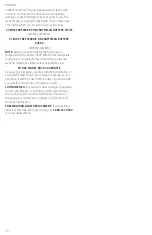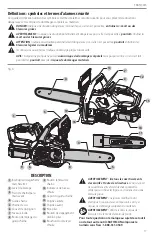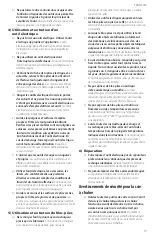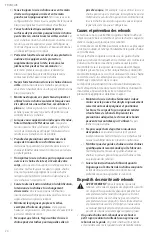
5
English
the ANSI performance requirements when used with
other saws.
•
Saw Chain -
A loop of chain having cutting teeth, that cut
the wood,and that is driven by the motor and is supported
by the guide bar.
•
Ribbed Bumper -
The ribs used when felling or bucking
to pivot the saw and maintain position while sawing.
•
Switch -
A device that when operated will complete or
interrupt an electrical power circuit to the motor of the
chain saw.
•
Switch Linkage -
The mechanism that transmits motion
from a trigger to the switch.
•
Switch Lockout -
A movable stop that prevents
the unintentional operation of the switch until
manually actuated.
The label on your tool may include the following symbols. The
symbols and their definitions are as follows:
V ......................... volts
Hz .......................hertz
min .....................minutes
or DC ......direct current
...................... Class I Construction
(grounded)
…/min ..............per minute
BPM ....................beats per minute
IPM .....................impacts per minute
RPM .................... revolutions per
minute
sfpm ................... surface feet per
minute
SPM ....................strokes per minute
OPM .................... oscillations per
minute
A .........................amperes
W ........................watts
or AC ...........alternating current
or AC/DC .... alternating or
direct current
...................... Class II
Construction
(double insulated)
no .......................no load speed
n .........................rated speed
......................earthing terminal
.....................safety alert symbol
.....................visible radiation
..................... avoid staring at
light
..................... wear respiratory
protection
..................... wear eye
protection
..................... wear hearing
protection
..................... read all
documentation
IPXX .................... IP symbol
Additional Safety Information
WARNING: ALWAYS
use safety glasses. Everyday
eyeglasses are NOT safety glasses. Also use face or
dust mask if cutting operation is dusty. ALWAYS WEAR
CERTIFIED SAFETY EQUIPMENT:
• ANSI Z87.1 eye protection (CAN/CSA Z94.3),
• ANSI S12.6 (S3.19) hearing protection,
• NIOSH/OSHA/MSHA respiratory protection.
WARNING:
Some dust created by power sanding,
sawing, grinding, drilling, and other construction
activities contains chemicals known to the State
of California to cause cancer, birth defects or
other reproductive harm. Some examples of these
chemicals are:
• lead from lead-based paints,
• crystalline silica from bricks and cement and other
masonry products, and
• arsenic and chromium from chemically-
treated lumber.
Your risk from these exposures varies, depending on
how often you do this type of work. To reduce your
exposure to these chemicals: work in a well ventilated
area, and work with approved safety equipment, such
as those dust masks that are specially designed to
filter out microscopic particles.
•
Avoid prolonged contact with dust from power
sanding, sawing, grinding, drilling, and other
construction activities. Wear protective clothing and
wash exposed areas with soap and water.
Allowing
dust to get into your mouth, eyes, or lay on the skin may
promote absorption of harmful chemicals.
WARNING:
Use of this tool can generate and/
or disperse dust, which may cause serious and
permanent respiratory or other injury. Always use
NIOSH/OSHA approved respiratory protection
appropriate for the dust exposure. Direct particles
away from face and body.
WARNING: Always wear proper personal hearing
protection that conforms to ANSI S12.6 (S3.19)
during use.
Under some conditions and duration
of use, noise from this product may contribute to
hearing loss.
CAUTION:
When not in use, place tool on its
side on a stable surface where it will not cause
a tripping or falling hazard.
Some tools will stand
upright but may be easily knocked over.
•
Air vents often cover moving parts and should be
avoided.
Loose clothes, jewelry or long hair can be
caught in moving parts.
•
Keep the working area free from obstructions such
as other trees, branches, rocks, fences, stumps, etc
.
Eliminate or avoid any obstruction that your saw chain could
hit while you are cutting through a particular log or branch.
•
Cut one log at a time.
•
Use extreme caution when re-entering a previous
cut
. Engage ribbed bumpers into wood and allow saw
chain to reach full speed before proceeding with cut.
•
Do not attempt plunge cuts or bore cuts.
•
Watch for shifting logs or other forces that could
close a cut and pinch or fall into saw chain.
•
Do not attempt operations beyond your capacity or
experience.
Read thoroughly and understand completely
all instructions in this manual.
•
Do not operate a chain saw with one hand!
Serious
injury to the operator, helpers, or bystanders may result
from one handed operation. A chain saw is intended for
two-handed use only.
•
Stop the chain saw before setting it down.








































